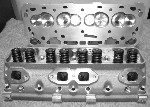I had a long talk we Vern Schumann today and the subject of Jerry's lifter failure came up. It is his opinion and I agree that the likely cause is tight valve guides. This happens far more often then you would think. In a stock Y-Block you would just fold-up the pushrod but in a race engine with high quality pushrods something else will give up. The broken rocker is also an indication the something was seriously wrong.
A lot depends on the type of guide used in the head as to the required stem clearance. I never use stainless valves in iron guides so no need to talk about correct clearance there. Iron guides can destroy stainless valves even with chrome plated stems. If using a thin wall bronze guideliner we shoot for .002" clearance on the intake valves and .0022" on exhaust. Some people will tell you that is too loose but experience has shown that guides with .0015" clearance will likely cause trouble in iron heads.
If you are using .502" OD bronze guides I would recommend even more clearance. .0022-.0025". The bronze is not dimensionally stable until many heat cycles.
When it comes to sizing valve guides my motto is: If the guide has a couple 10,000ths more clearance than might be required the customer will never know it. If it has a couple 10,000ths too little he will hate you.
I think that Jerry should disassemble his heads and have someone carefully check the valve guide clearance!!!!
BTW, he was not using the aluminum heads I sent him.
It is too easy to blame the broken part for a failure. How often is a broken connecting rod really an oiling problem? A broken ring or pounded out rod bearing a detonation problem? In other words, a rod bearing failure could be caused by an ignition or A/F problem. If Jerry had only broken a lifter it would be tempting to blame the lifter but with a broken rocker arm also, something in the valve train was binding up.
I have sold 1000s of the Schumann lifters and lifters from the same manufacturer (Vern does QC for the other vendor) with an extremely low failure rate. I did replace 2 for a shop that broke during engine assembly! I suspect the "mechanics" broke them by beating a tight cam gear on and using a lobe/lifter for a back stop.
Also, if you are rotating the crank without the full cam assembly bolted on allowing the cam to slip back while rotating, 2 lobes can be forced between lifter heads. I would guess that some lifters have been broken this way.
Now you have my 2 cents worth.
http://ford-y-block.com 20 miles east of San Diego, 20 miles north of Mexico
